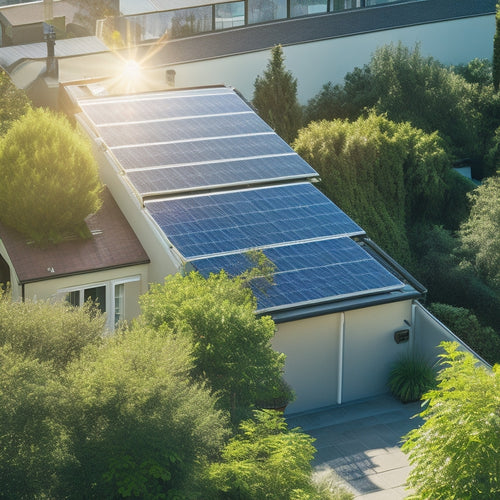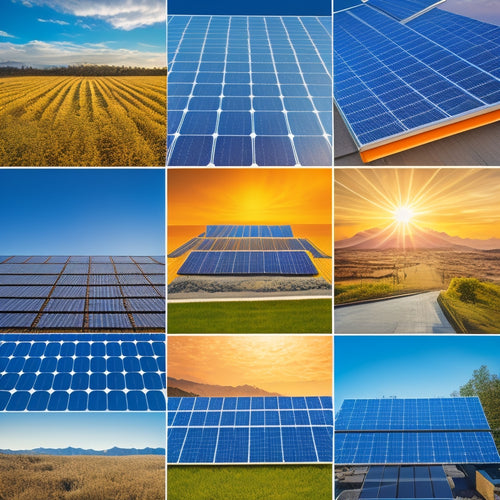
3 Best Financing Solutions for Commercial Solar Systems
Share
You're considering financing options for a commercial solar system and want to know the best solutions. You have three primary options: commercial loan financing, solar panel leasing programs, and power purchase agreements. Commercial loans offer secured or unsecured options with varying interest rates and repayment terms. Solar panel leasing programs provide predictable energy costs with no upfront costs and minimal maintenance responsibilities. Power purchase agreements allow you to buy electricity at a fixed rate from a third-party developer while avoiding upfront costs and project risks. Each option has its benefits and trade-offs, and understanding the nuances of each can greatly impact your return on investment - let's dig deeper.
Key Takeaways
• Secured loans offer lower interest rates and longer repayment terms, making them a viable option for commercial solar systems.
• Unsecured loans provide an alternative for businesses without collateral, but with higher interest rates and stricter repayment terms.
• Solar panel leasing programs allow businesses to adopt solar energy with predictable energy costs and minimal maintenance responsibilities.
• Power Purchase Agreements (PPAs) enable companies to buy electricity at a fixed rate from a third-party developer, avoiding upfront costs and project risks.
• Term loans provide a lump sum upfront and fixed repayment schedule, ideal for businesses that prefer to own their solar panel systems.
Commercial Loan Financing Options
You can explore several commercial loan financing options to fund your solar system, including secured and unsecured loans, each with its own benefits and drawbacks.
Secured loans, for instance, require collateral, but offer lower interest rates and longer repayment terms. Unsecured loans, on the other hand, carry higher interest rates but don't require collateral.
Term loans are a popular option, providing a lump sum upfront and a fixed repayment schedule. These loans can be tailored to fit your business's cash flow, with repayment terms ranging from 5 to 10 years.
Construction financing is another option, allowing you to finance the installation of your solar system in stages, with disbursements tied to project milestones. This approach can help manage cash flow and minimize upfront costs.
By understanding the pros and cons of each loan type, you can make an informed decision that aligns with your business goals and financial situation.
Solar Panel Leasing Programs
Solar panel leasing programs allow businesses to utilize solar energy without incurring the upfront costs of purchasing and installing a system, providing a flexible and affordable alternative to traditional financing options. With a leasing program, you'll pay a fixed monthly fee to use the solar panel system, which can be tailored to fit your business's energy needs.
Here are some benefits of solar panel leasing programs:
-
Predictable Energy Costs: You'll know exactly how much you'll be paying for energy each month, allowing you to better manage your budget.
-
No Upfront Costs: You won't have to pay the high upfront costs of purchasing a solar panel system, freeing up capital for other business expenses.
-
Tax Benefits: You may be eligible for tax benefits, such as depreciation and interest deductions, which can help reduce your taxable income.
-
Equipment Upgrades: Leasing programs often include equipment upgrades, ensuring you have access to the latest technology.
-
Minimal Maintenance: The leasing company is typically responsible for maintenance and repairs, reducing your operational expenses.
Power Purchase Agreements
Through power purchase agreements, businesses can buy electricity at a fixed rate from a third-party developer that installs and maintains a commercial solar system on their property. This financing solution allows you to enjoy the benefits of solar energy without shouldering the upfront costs or project risks. You'll get to lock in a fixed electricity rate for a set period, usually 10 to 20 years, which can be lower than your current utility rate.
In return, the developer gets to claim the tax benefits and sell the excess energy back to the grid. You'll reap the energy savings without having to manage the system, as the developer will handle maintenance and repairs. This arrangement also allows you to avoid the risks associated with owning a solar system, such as technology obsolescence and equipment failure.
With a power purchase agreement, you can focus on your core business while enjoying the benefits of renewable energy. You'll reduce your carbon footprint, lower your energy bills, and contribute to a sustainable future.
Frequently Asked Questions
What Are the Typical ROI Expectations for Commercial Solar Investments?
You can expect a typical ROI of 10-15% from commercial solar investments, as solar savings from reduced energy bills and increased energy efficiency lead to significant returns, liberating you from rising energy costs.
How Do Tax Incentives Impact Commercial Solar Financing Decisions?
You're "cutting to the chase" when considering commercial solar financing, and tax incentives play a significant role. A thorough Tax Benefit Analysis reveals the impact of incentives on ROI, and Incentive Scalability helps you maximize benefits, liberating your investment from unnecessary costs.
Can Commercial Solar Systems Be Used as Collateral for Financing?
You can use your commercial solar system as collateral for financing, leveraging the solar asset's value to secure a loan, thereby increasing financing flexibility and accessing more funding options to support your renewable energy goals.
What Are the Primary Risks Associated With Commercial Solar Financing?
You might think commercial solar financing is a slam dunk, but you're mistaken - you need to take into account the primary risks, including technology and performance risks, which affect your risk assessment and ability to maintain financial leverage.
How Do Financing Options Vary for Non-Profit Organizations Versus For-Profits?
When exploring financing options, you'll find that non-profits can tap into grant funding, leveraging their social impact to secure capital, whereas for-profits focus on traditional financing methods, such as loans and investments, to fund their commercial solar projects.
Related Posts
-

How Solar Panels Reduce Electricity Bills
Solar panels can drastically cut your electricity bills by utilizing sunlight to generate your own energy. This decre...
-

High-Performance Solar Solutions for Sustainable Living
High-performance solar solutions are your gateway to sustainable living, maximizing energy efficiency while considera...
-

Comparative Analysis of Top Solar Brands
To conduct a comparative analysis of top solar brands, focus on key metrics like durability, energy efficiency, and s...


